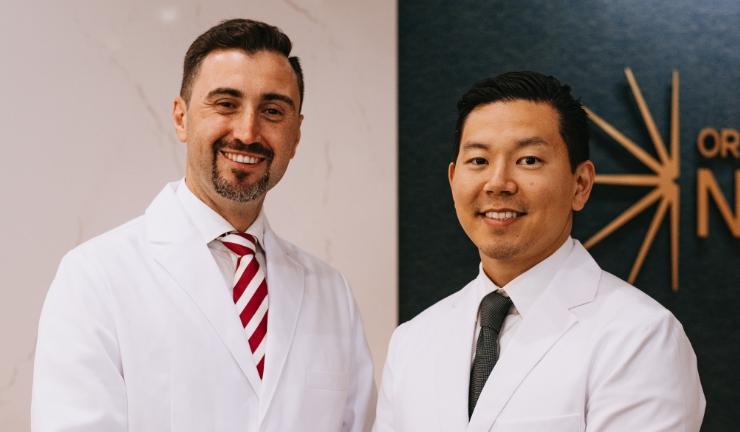After surgery, the wound or sutures should not be touched or disturbed by your tongue or fingers for two weeks. You might notice a metal or white-colored material, which is the healing abutment that protrudes through the gum tissue. This post is attached to the implant, with a healing abutment to form the gum opening where the future tooth will be placed. Do not chew on the gum in this area since the pressure and food can disrupt the implant healing.
Placing a dental implant is a surgical procedure, which is why postoperative care is important. You can avoid unnecessary pain and swelling by following these instructions to avoid infection and other complications.
Read these instructions carefully so you understand the normal reactions after surgery. This information is provided to help you be as comfortable as possible during recovery.
Early Care After Surgery
On the day of the surgery, patients have optimal results when following this sequence:
- Control Bleeding First: The patient should stay in a sitting position and bite on gauze until the bleeding stops. Do not spit. Apply ice packs to the affected areas immediately.
- Eat Something: Getting something in the stomach is important. A milkshake is suggested.
- Start Medications: If the patient is experiencing pain, then the pain medication should be taken first, followed by the antibiotic an hour later. If the patient is not experiencing pain, then the antibiotic should be taken first, with the use of pain medication when the pain is starting to occur.
Bleeding
Apply moistened sterile gauze (a thumb-size roll) or a teabag over the wound. Bite hard with constant pressure for an hour, using 80% of your maximum bite force. The bulk of the gauze should be placed over the socket directly, so it acts as a barrier to minimize the amount of blood that is exiting the socket.
If the mouth is filling up with blood, then it means that the gauze is not sealing off the area. The gauze should be adjusted to achieve a better seal. Another cause for blood filling the mouth is if intermittent pressure is applied on the gauze or the patient starts talking, causing the gauze to move out of position.
Even when the above techniques are used properly, it may take as long as 3 to 4 hours for the bleeding to stop. If you were shown a specific technique to stop the bleeding, please use that method.
Ignore bloodstain on the gauze as a sign of bleeding. Ideally, someone other than the patient should check for bleeding and help with the gauze application. At the end of each hour, the gauze should be removed and the wound needs to be checked for further bleeding. Look at the wound directly for 20–30 seconds, using a flashlight and spoon handle (as a retractor) if needed. Don’t be surprised if the patient can’t open wide. A partial opening should be sufficient for you to see if it is bleeding.
Variable bleeding is expected after oral surgery. It is not uncommon to experience oozing, slight bleeding, or redness in the saliva.
If the bleeding does not stop, then call our office for further instructions. In the first 24 hours, it is normal to have minimal bleeding and red or pink saliva. Also, bleeding can occasionally recur through the week after surgery. Usually, the bleeding will stop by itself, but pressure gauze can be applied if the bleeding is persistent.
Consider placing a towel to cover your pillow the night of the surgery. Minor oozing and drooling might occur while sleeping.
Pain
The first 12–24 hours are usually when the most discomfort is experienced. Severe pain can be treated using the prescribed medications, taken as directed. Moderate pain can be treated using ibuprofen (Advil or Motrin: 200mg tablets, taken every 3–4 hours). Tylenol can be used as well, following the dosage recommendations as listed on the package.
Keep in mind that most pain medications can cause an upset stomach. The risk of stomach discomfort is highest when medication is taken on an empty stomach and prescription pain medication is used. If general anesthesia was used and the stomach is empty, then it is recommended to drink a milkshake followed by the first dose of medication 30 minutes later. A more effective option is to eat something soft and bulky (mashed potatoes, oatmeal, ground meat, etc.) 30 minutes before the medication.
Antibiotics
If you have been prescribed antibiotics, then the first dosage should be taken 1 hour after taking pain medication. Continue using this medication as prescribed until the entire prescription has been finished.
Be aware that antibiotics might decrease the effectiveness of other medications, such as birth control pills. Talk to your obstetrician to know how long alternative birth control methods should be used after stopping the antibiotic.
Swelling
Drs. Blecha and Jandali use precise surgical techniques to minimize and prevent swelling whenever possible. But the swelling that occurs will be proportional to the procedure. It is common for patients to experience swelling around the cheeks, mouth, eyes, and sides of the face. This reaction is expected and a normal part of the healing process. Usually, the swelling peaks within 72 hours, then will take 5–6 days to subside.
Ice packs can be used for swelling reduction. If you don’t have ice packs, homemade packs can be created using a Ziploc bag filled with ice. All ice packs should be wrapped in a dry washcloth or hand towel before applying the pack on the sides of the face.
Ice can be used in 30-minute intervals: 30 minutes on, 30 minutes off. Start the ice pack treatment on the day of the surgery and continue as needed – up to 72 hours after the surgery. After 72 hours, you can bring the swelling down by placing moist, warm, heat applications on the sides of the face.
Smoking
It is recommended that patients should not smoke after implant surgery. The implants should be healed before smoking because smoking can have a negative impact on bone implant healing.
Diet
Reestablishing your diet after oral surgery is beneficial to promote healing. Chewing might be difficult in the first 5–6 days if your jaw is stiff and difficult to open.
When the bleeding stops, we recommend a milkshake. Next, patients can move on to soft, bulky foods, such as oatmeal, mashed potatoes, and ground meat. These ingredients are important in preventing vomiting and nausea from the use of medications.
Ask a family member to chop up the foods into small enough pieces so you can eat them with a spoon and swallow without chewing. Drink 5–6 glasses of liquid per day to supplement the bulky foods.
Even if your jaw is stiff and sore, you must be consistent with eating bulky foods so your stomach can tolerate your medications.
Please follow the implant surgery dietary instructions provided by our office staff. If one or more implants were placed, you can eat normal foods on the day of the surgery. But it is important to not chew the foods in the implant area. Take smaller bites (half of your normal bite) to keep the food away from the implant.
If all of the teeth were removed and you have a placement of temporary teeth (All on Four Implants), then your diet is restricted to anything that can be cut with a plastic fork (not a plastic knife or spoon).
Remember: The success of your implants depends on your adherence to these instructions and dietary restrictions during the healing period.
Nausea and Vomiting
The risk of postoperative nausea and vomiting is highest when the patient isn’t eating well and is taking postoperative medications. Pain medications are commonly the cause of stomach upset.
If nausea and/or vomiting is experienced after the surgery, then don’t eat or take anything by mouth for an hour (including prescribed medications). Slowly sip on a Sprite or Coke for 15 minutes.
When the nausea subsides, try to eat bulky foods (as listed above). If these foods are tolerated, then you can try to resume the use of medications once again. Usually, the narcotic pain medication is the cause of nausea. If these prescriptions are needed for pain management, be slow in resuming the use of the prescription and try taking a lower dose to minimize nausea.
Oral Hygiene
Do not rinse or brush your teeth for 24 hours after surgery. After 24 hours, clean the mouth by brushing and following the salt-water rinses as directed below. Keep in mind that good hygiene after surgery is essential to help your mouth heal faster and to reduce the pain as quickly as possible. If you are too “shy” to brush and rinse, then it increases the likelihood of the development of a postoperative wound infection and pain that worsens.
Twenty-four hours after tooth extraction, all of the teeth should be brushed (including the teeth adjacent to the surgical site). Don’t scrub too hard. Instead, carefully clean the surface of all teeth, including “nooks and crannies” where food can get stuck.
At this time, you should also start using salt-water rinses. Mix 1/2 teaspoon salt in a glass of warm water, then gently “swish” to remove food that gets stuck in the surgical wounds. You should brush and rinse – saltwater swishing does not replace brushing.
If you find it difficult to open your stiff jaw 4–5 days after surgery, then stretching exercises can be used so you can open your mouth wider. Not only will opening your mouth wider make it easier to clean your teeth, but it also improves your ability to eat.
Use a soft bristle brush and toothpaste, with gentle, careful motions to clean the teeth. Do not brush the abutment post, but the adjacent teeth can be brushed carefully. If you have a temporary tooth, then it can be gently brushed at the gum line.
Make sure to rinse food out of the wound with a warm saltwater solution (1/2 teaspoon salt in a glass of warm water). This rinsing can be repeated every 3–4 hours.
Follow the instructions for brushing and saltwater rinses daily until talking to your doctor at the postoperative appointment.
REMEMBER: A clean wound heals better and faster.
Physical Activities
If general anesthesia was used for the surgery, the patient should lay on a couch or bed until the anesthesia and sedative effects wear off. Within 6 hours, the patient will be able to move around a little bit, but they should not drive, operate machinery, work, or drink alcohol for 12–24 hours (until all sedative effects have resolved). These restrictions also apply to the use of prescription pain medication, for 6–8 hours until after the last dose.
It is advised to avoid physical exertion and exercise for 5–6 days after surgery.
Discoloration
Some patients experience skin discoloration after surgery. When the blood spreads beneath the tissues, it can cause the development of green, blue, black, or yellow discoloration. This postoperative discoloration is normal, and usually shows up 2 or 3 days after surgery. Moist heat can be applied to the area to speed up the healing and fade the discoloration.
Sore Throat & Corners of the Mouth
The IV anesthesia or extractions can cause the development of a sore throat. The throat muscles are near the surgical site, and it can cause pain when these muscles swell. This pain is normal and should subside in 2–3 days. Saltwater gargling can help to reduce the pain.
During the surgery, the corners of the mouth can be stretched – causing them to crack and dry out. This discomfort can be managed by applying lip balm or an ointment (such as Vaseline) to keep the corners of the mouth moist.
Wearing Your Prosthesis
Drs. Blecha and Jandali will review your unique situation on a case-by-case basis to determine if you should use temporary teeth (partial dentures, flippers, or full dentures). This treatment option will be discussed in the preoperative consultation, as well as postoperative instructions.
You May Experience
- Swelling around the surgical site
- Muscle stiffness, causing difficult when opening the mouth or moving the cheek or lips
- A minor earache
- Pain in other teeth
- Cracked, dry lips
- An increase in body temperature for the first 1 – 2 days
- Black or blue discoloration on the outside of the face and/or neck. The discoloration will resolve in several days, as described above.
It is common to place sutures in the area of surgery to help with healing and minimize post-operative bleeding. Do not play with the sutures. Sometimes, they become dislodged. Don’t be alarmed – simple remove the suture from the mouth and discard it. Depending on your surgery and individual situation, the sutures may or may not be dissolvable.
No two mouths are alike, which is why every patient needs personal recommendations from the doctor. Your friends might offer well-intended advice, but you should always listen to the recommendations of the doctor.
Drs. Blecha and Jandali and our staff are here to support you in a comfortable, speedy recovery. If any questions or problems arise after surgery, please contact our office for assistance.



